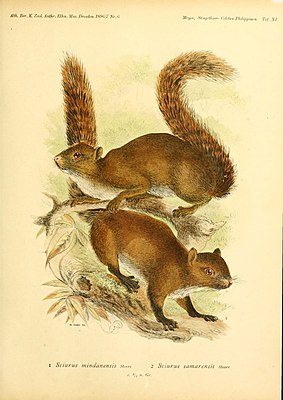Mindanao croissants
| Mindanao croissants | ||||||||||||
|---|---|---|---|---|---|---|---|---|---|---|---|---|

Mindanao squirrel ( Sundasciurus mindanensis ) (above), below a samar squirrel ( Sundasciurus samarensis ) |
||||||||||||
| Systematics | ||||||||||||
|
||||||||||||
| Scientific name | ||||||||||||
| Sundasciurus mindanensis | ||||||||||||
| ( Steere , 1890) |
The Mindanao squirrel ( Sundasciurus mindanensis ) is a species of squirrel from the genus of the Sunda tree squirrel ( Sundasciurus ). It lives on the Philippine island of Mindanao .
features
The Mindanao croissant reaches a head-torso length of about 19.3 to 20.3 centimeters with a weight of about 285 grams. The tail is about 17.1 to 19.1 centimeters long, making it slightly shorter than the rest of the body. The back and tail color of the animals is uniformly dark gray with hair that is black at the base, sand yellow in the middle and black again at the tips. The color on the back line is darker than on the sides of the body, the hips and the tops of the feet are reddish-gray and the nose and eye region are also reddish. The sides of the body and the abdomen are ash gray.
In terms of color, it corresponds to the Samar squirrel ( Sundasciurus samarensis ), in comparison the Samar squirrel is usually somewhat larger and has no eye ring, and the hips and the nasal region are a solid gray.
distribution
The Mindanao squirrel is endemic to the Philippine island of Mindanao and some of the smaller islands in the area.
Way of life
No data are available on the way of life of the Mindanao croissant. Like the Philippines squirrel, it lives in primary and secondary forests and is likely to be found in agricultural land as well.
Systematics
The Mindanao squirrel is classified as an independent species within the genus of the Sunda tree squirrel ( Sundasciurus ), which - depending on the author - consists of 15 to 17 species. The first scientific description comes from Joseph Beal Steere from 1890, who described the species on the basis of individuals from the island of Mindanao. A conspecificity with other island species of the genus such as the Davao squirrel ( Sundasciurus davensis ), the Philippines squirrel ( Sundasciurus philippinensis ) and the Samar squirrel ( Sundasciurus samarensis ) is possible.
Apart from the nominate form, no further subspecies are distinguished within the species .
Status, threat and protection
The Mindanao croissant is listed as Least Concern by the International Union for Conservation of Nature and Natural Resources (IUCN). This is justified with the comparatively large distribution area and the locally frequent occurrence as well as the ability to adapt to changed habitat conditions. There are no known threats to the population, but it is likely - like the Philippines croissant - partly caught and sold for the pet trade or hunted as a source of meat.
supporting documents
- ↑ a b c d e Richard W. Thorington Jr., John L. Koprowski, Michael A. Steele: Squirrels of the World. Johns Hopkins University Press, Baltimore MD 2012; 189. ISBN 978-1-4214-0469-1
- ↑ a b c d e Sundasciurus mindanensis in the IUCN Red List of Threatened Species 2014.3. Posted by: F. Chiozza, 2008. Retrieved January 4, 2015.
- ↑ a b c d Sundasciurus mindanensis In: Don E. Wilson , DeeAnn M. Reeder (Ed.): Mammal Species of the World. A taxonomic and geographic Reference. 2 volumes. 3. Edition. Johns Hopkins University Press, Baltimore MD 2005, ISBN 0-8018-8221-4 .
literature
- Richard W. Thorington Jr., John L. Koprowski, Michael A. Steele: Squirrels of the World. Johns Hopkins University Press, Baltimore MD 2012; 189. ISBN 978-1-4214-0469-1
Web links
- Sundasciurus mindanensis inthe IUCN Red List of Threatened Species 2014.3. Posted by: F. Chiozza, 2008. Retrieved January 4, 2015.